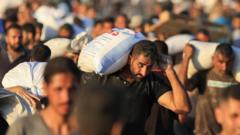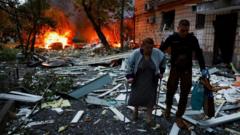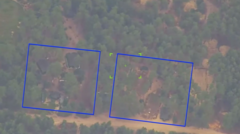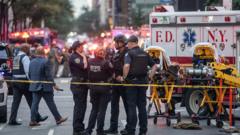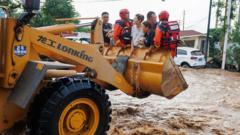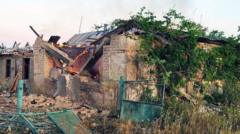A devastating crowd crush at the Kumbh Mela festival in Prayagraj, India, has resulted in the loss of at least 30 lives, with numerous others injured, raising concerns over crowd management and safety protocols at this massive religious event.
Tragedy Strikes Kumbh Mela Festival as Crowd Surge Claims Lives
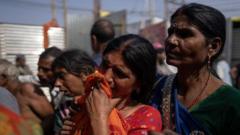
Tragedy Strikes Kumbh Mela Festival as Crowd Surge Claims Lives
At least 30 fatalities reported as chaos ensues during the sacred Hindu pilgrimage in Prayagraj, India.
At least 30 pilgrims have lost their lives following a horrific crowd surge during the Kumbh Mela, a mega Hindu festival renowned for drawing millions of attendees. Early reports indicate that the incident occurred on Wednesday morning as devotees rushed toward the riverbanks of Prayagraj for ritual bathing, leading to chaos and panic as people became trapped amid the throng of fellow pilgrims. Authorities confirmed that around 60 others sustained injuries in the stampede.
Eyewitness accounts depicted a harrowing scene, with personal belongings scattered across the site and cries for help echoing in the air. The event sparked a wave of concern and frustration regarding the adequacy of safety measures in place at an occasion attended by large crowds, which can exceed 100 million participants on key bathing days.
India's Prime Minister Narendra Modi extended condolences to the bereaved families, emphasizing the gravity of the incident while the chief minister of Uttar Pradesh, Yogi Adityanath, expressed his wishes for a swift recovery for the injured. However, opposition leaders criticized the government for failing to manage the crowds effectively, citing a lack of transparency regarding the casualty count.
The Kumbh Mela, held every 12 years at the sacred confluence of the Ganges, Yamuna, and the invisible Saraswati rivers, experiences pilgrimage peaks during significant ritual days. The crush took place on the Shahi snan, a day traditionally associated with ceremonious bathing practices, drawing the largest crowds and reverence.
As the day unfolded, reports revealed growing confusion surrounding the casualty figures. Devotees lost track of relatives amid the chaos, and many were reported missing. The tumult extended throughout the day as rescue operations commenced and victims were taken to hospitals for treatment.
Amidst the surrounding disarray, the festival, which began on January 13 and is slated to continue until February 26, 2024, still attracted multitudes, urging those attending to take caution. Despite the tragic event, the significance of the Kumbh Mela remains high among Hindu devotees who believe that participating in the sacred waters can absolve them of sins.
Authorities declared a new focus on crowd management post-incident, yet skepticism remains as victims' families continue to seek missing loved ones in the aftermath of the tragedy. Many put the onus of this disaster on the local administration, underscoring the necessity for better preparedness for future events of this scale.
Eyewitness accounts depicted a harrowing scene, with personal belongings scattered across the site and cries for help echoing in the air. The event sparked a wave of concern and frustration regarding the adequacy of safety measures in place at an occasion attended by large crowds, which can exceed 100 million participants on key bathing days.
India's Prime Minister Narendra Modi extended condolences to the bereaved families, emphasizing the gravity of the incident while the chief minister of Uttar Pradesh, Yogi Adityanath, expressed his wishes for a swift recovery for the injured. However, opposition leaders criticized the government for failing to manage the crowds effectively, citing a lack of transparency regarding the casualty count.
The Kumbh Mela, held every 12 years at the sacred confluence of the Ganges, Yamuna, and the invisible Saraswati rivers, experiences pilgrimage peaks during significant ritual days. The crush took place on the Shahi snan, a day traditionally associated with ceremonious bathing practices, drawing the largest crowds and reverence.
As the day unfolded, reports revealed growing confusion surrounding the casualty figures. Devotees lost track of relatives amid the chaos, and many were reported missing. The tumult extended throughout the day as rescue operations commenced and victims were taken to hospitals for treatment.
Amidst the surrounding disarray, the festival, which began on January 13 and is slated to continue until February 26, 2024, still attracted multitudes, urging those attending to take caution. Despite the tragic event, the significance of the Kumbh Mela remains high among Hindu devotees who believe that participating in the sacred waters can absolve them of sins.
Authorities declared a new focus on crowd management post-incident, yet skepticism remains as victims' families continue to seek missing loved ones in the aftermath of the tragedy. Many put the onus of this disaster on the local administration, underscoring the necessity for better preparedness for future events of this scale.








